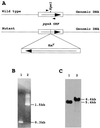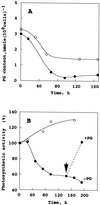Direct evidence for requirement of phosphatidylglycerol in photosystem II of photosynthesis
- PMID: 11027727
- PMCID: PMC59183
- DOI: 10.1104/pp.124.2.795
Direct evidence for requirement of phosphatidylglycerol in photosystem II of photosynthesis
Abstract
Phosphatidylglycerol (PG) is considered to play an important role in the ordered assembly and structural maintenance of the photosynthetic apparatus in thylakoid membranes. However, its function in photosynthesis remains poorly understood. In this study we have identified a pgsA gene of Synechocystis sp. PCC6803 that encodes a PG phosphate synthase involved in the biosynthesis of PG. A disruption of the pgsA gene allowed us to manipulate the content of PG in thylakoid membranes and to investigate the function of PG in photosynthesis. The obtained pgsA mutant could grow only in the medium containing PG, and the photosynthetic activity of the pgsA mutant dramatically decreased with a concomitant decrease of PG content in thylakoid membranes when the cells grown in the presence of PG were transferred to the medium without PG. This decrease of photosynthetic activity was attributed to the decrease of photosystem (PS)II activity, but not to the decrease in PSI activity. These findings demonstrate that PG is essential for growth of Synechocystis sp. PCC6803 and provide the first direct evidence that PG plays an important role in PSII.
Figures





References
-
- Allen MM. Simple conditions for growth of unicellular blue-green algae on plates. J Phycol. 1968;4:1–4. - PubMed
-
- Arnon DI, McSwain BD, Tsujimoto HY, Wada K. Photochemical activity and components of membrane preparations from blue-green algae: I. Coexistence of two photosystems in relation to chlorophyll a and removal of phycocyanin. Biochim Biophys Acta. 1974;357:231–245. - PubMed
-
- Aro E-M, Hundal T, Carlberg I, Andersson B. In vitro studies on light-induced inhibition of photosystem II and D1-protein degradation at low temperature. Biochim Biophys Acta. 1990;1019:269–275.
-
- Aro E-M, Virgin I, Andersson B. Photoinhibition of photosystem II, protein damage and turnover. Biochim Biophys Acta. 1993;1143:113–134. - PubMed
Publication types
MeSH terms
Substances
LinkOut - more resources
Full Text Sources

